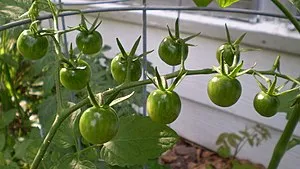How many seeds are in the average tomato?

This activity would be a great to do towards the end of a seed unit, once students have already learned about what a seed needs to grow and also seed dispersal. I like the connections and debates that occur often here, even with very young children.
Begin by having pupils guess how many seeds they believe are in a cherry tomato (hold one up to help with the predictions).

Record predictions on the board and tell students we are going to look inside a cherry tomato to find out how many seeds. Split each tomato in half so they may readily investigate the insides. One tomato per pupil is required for older students. If you have smaller pupils, consider giving each one half to make counting simpler and more doable. When I did this, we generally discovered 60-90 seeds per cherry tomato. I prefer to give the pupils little paper plates to lay out the seeds on while counting. After students finish counting, allow them to record their results on the board for everyone else to see.
Contrast expectations with actual figures. If your class is old enough, you may calculate the average number of seeds per tomato. If you are working with younger students who counted half tomatoes, compute the number on seeds in one tomato on the board for the students to see (by adding the number’s from each half).

Next, if you have a cherry tomato plant in the garden, inspect it to see how many cherry tomatoes are growing on the one plant (if you don’t have a cherry tomato plant, you may want to show a picture of one and count the tomatoes growing in the picture). Encourage your younger kids to visualize how many seeds there must be on the plant right now, with all of those seeds inside all of those tomatoes. For older kids, you may calculate how many seeds are on your tomato plant (average number of seeds per tomato multiplied by the number of tomatoes).
Now you can get so some really rich discussion….
Ask pupils whether they believe every seed will grow into a plant. What would the garden look like if every seed grew into a plant? Ask kids why they believe the plant produces SO MANY seeds. Why aren’t some of the seeds sprouting? Explain the many reasons why seeds do not become plants (they are crushed and eaten, they fall on concrete (no soil), they fall in a desert (no water), they fall in water (no air), they fall in a shade (no sun), and so on). Allow for student involvement and inquiries, and you’ll be astonished at the connections and understandings they generate.
Now is a terrific time to read Eric Carle’s “The Little Seed,” a book about a seed traveling with a huge group of seeds, many of whom do not grow up as plants for different reasons. I like to close the book by stating something like, “good thing the flower produced so many seeds, since just one of the seeds survived to become a new plant…” and then I might ask, what if there was only one seed from the flower?





